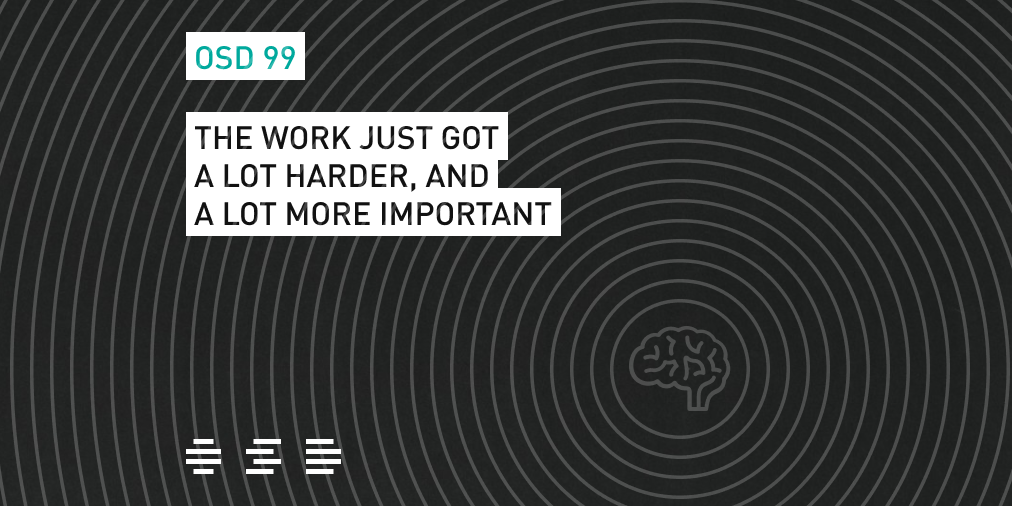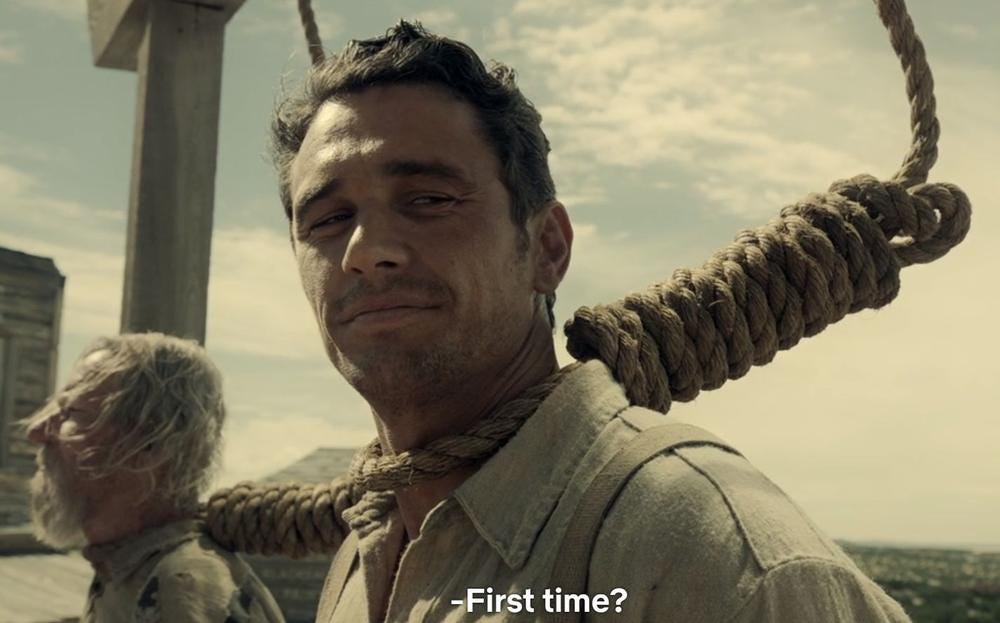OSD 99: The work just got a lot harder, and a lot more important
The hard times are why we’re here.
You know, it’s fitting that we’re up to OSD 99 this week. It was a 99 kind of week: momentous but also somehow repetitive; arriving at the end of a series; the last step before something new starts. But unlike with numbers, we don’t know exactly what comes next. That can be scary. Hell, it is scary.
We’ve had this section on our site ever since it launched:
Culture not politics
The graveyard of history is full of ideas that were right. So it’s not enough to be right. You have to be right and effective. We measure ourselves by our results. “Things would be great if all those people on the other side would just agree with us” is a cop-out, not a strategy. And both sides have used it for too long.
But that shouldn’t be surprising. It’s how politics works. When people are locked into a culture war over what should be normalized vs. what should be stigmatized, what matters is scoring points wherever they can. The logical coherence of the win doesn’t matter, and in fact caring about the reasonableness of your policies is a sure way to lose.
Because while you’re off like Plato finding the perfect law, the other side is either normalizing themselves to escape velocity, or stigmatizing you to extinction. Once either happens, they win and the discussion ends forever.
We’re not here to play the game, we’re here to change the game.
Culture drives politics, not the other way around. Therefore begging partisans to do the right thing is a waste of time.
Historically, it’s rare that opponents of progress change their mind. Progress doesn’t happen by convincing them to switch. Typically, it happens by new facts on the ground simply making the old guard irrelevant. They stay complaining and stay fighting the tide, but ever-more laughably as they fade into the past.
Guns-as-politics is an old-fashioned way of thinking. We believe culture is the highest-leverage point to focus our efforts.
We wrote that because when emotions flare up, that’s when it’s most important to remember your principles — and most tempting to forget them. And this week we saw a glimpse of what happens when every tribe forgets about cultural persuasion and adopts an everything-as-politics framing instead.
Gun rights weren’t a discussion in all the chaos, but that’s only because everyone was busy entering the atmosphere that gun rights have been living in for years. Forget apps; radio stations started bleeping the word “gun” in songs decades ago. Watching a spate of deplatformings rapidly escalate, gun rights folks have one thought:
Yeah, that’s scary. There’s no question that this is a dangerous moment — we are watching cultural tides shift before our eyes, and there is no guarantee where they’ll land. And to be clear, we’re writing about it here because access to internet infrastructure is critical to the future of gun rights. There is no getting around that. So we need it to land in a good spot.
A lot of the discussion on this stuff has focused on what is legal. But that makes the same mistake as focusing on politics before culture. People allow things to be legal if they like them, not the other way around. As we said in OSD 92: “From world history, US history, and even recent US history, there’s a stark lesson in this: unpopular minorities do not survive. You can be unpopular. You can be in the minority. But you can’t be both — at least not for long.” A society’s laws are just the tldr of its norms.
@perrymetzger on Twitter wrote a great thread on why that distinction matters (edited a bit for brevity):
There is a distinction between what is something you ought to do and what is legal. It is legal to drink yourself to death. It is probably not a good idea. The distinction is not a small one. Let’s apply it to the social norms many people suggest we adopt on silencing others.
I hear quite frequently arguments to the effect that private platforms are legally allowed to silence people. And yes, they are, and yes, they should be. Is this a good idea, though? Let’s have a quick look for a moment.
It’s possible to imagine a society where every restaurant refuses service to people of the wrong political background, every supermarket checks to see if people arriving match a particular political affiliation before selling them groceries.
We can imagine neighbors only talking to other neighbors of the correct political tribe, jobs refusing to allow people with the wrong political beliefs to apply, etc. This is probably a thing that is legal or at least ought to be legal.
Is it, however, a recipe for a peaceful society?
…
Our society developed norms long ago that said “we try to ignore our neighbors political, social, and religious beliefs, not because we agree with them or wish to promote them, but so that they too will tolerate ours and everyone will get along peacefully.”
Right now, we’re seeing an unprecedented erosion of this centuries-standing social compact, and it is not doing good things for our society. Yes, we can deplatform our enemies, we can deny the wrong news outlet internet connectivity for its servers.
We can kick people we think go beyond some sort of line off our platforms, we can try to keep them from communicating. I don’t think it’s a good idea. I think in the end it simply feeds the narrative that our society is biased against certain tribes, and radicalizes people.
Worse, it slowly walks down the path towards a society where people divide ever more sharply by political views, treat members of other tribes who live near them as enemies who must not be interacted with, and leads, I think, to an inevitable social disintegration.
Frankly, I do not want to live in a society where everyone divides up into two economies, two internets, two sets of app stores, all segregated by political tribe. That’s the path we’re going. That path leads to violence at an unprecedented scale.
Sure, you’re legally allowed to stop selling firewood to your neighbors if they have the wrong yard sign up for the wrong presidential candidate, but if you go down that path, you end in a place that isn’t very pretty at all.
I would strongly prefer that we de-escalate, not that we give in to the impulse to dig in deeper. Yes, there are some pretty horrible people out there with little to no moral compunction about lying and calling for violence, and they include prominent politicians.
But we do not demonstrate that there is an alternative path towards a tolerant, peaceful, pleasant society by adopting their methods and demonstrating that their claims that people are trying to silence them are correct.
You cannot fuck you way to celibacy, you cannot shoot your way towards non-violence, you cannot censor your way towards tolerance for minority viewpoints. In short, you cannot get where you're going by adopting the tools of the intolerant.
…
We have a lot more work to do to build up the cultural norms that’ll make gun rights widely valued. There’s been more progress than people think over the past couple decades, and one out of every nine US gun owners became a gun owner in 2020. But the topic has also gotten more polarized, and six of the seven states with gun feature bans ratcheted their bans tighter during the 2010s.
By sheer coincidence, it was only last week in OSD 98 that we publicly shared our mission for the first time:
Mission
Create the infrastructure for gun rights: build the TCP/IP layer of the gun rights stack.
Everybody is operating at the application layer — building a company or org to solve a specific problem, address a specific customer segment, etc. So everyone’s trying to add innovation, which is good. But few are effectively working on the infrastructure layer, to accelerate the underlying rate at which others can innovate.
We first wrote that down almost a year ago, but it has never been more relevant. The TCP/IP metaphor was deliberate, for times exactly like what we’re going through now: TCP/IP is a platform. Technically, it’s a platform of platforms. And that’s the level we all need to think at. Build norms that make the most of every layer in the stack below you, and which form a rock-solid foundation for every layer in the stack above you. Now more than ever.
This week’s links
Garand Thumb’s 80,000 round review of the Surefire SOCOM RC
Tfw Garand Thumb points out that urine can be an ablative medium for shooting your suppressor wet 😳.
Why plainclothes police had striped reflective tape on their Glocks during the Capitol siege
Mildly interesting gear note about some pictures you probably saw in the news.
Record gun sales and diverse ownership mean rocky prospects for restrictions
Slightly aspirationally headlined, but this is a good summary of what happened to the demographics of gun ownership in 2020.
What is gun culture? Cultural variations and trends across the United States.
A new study from Boston University, which produces some significantly-more-thoughtful-than-average sociological research on gun stuff. (Our own BJ Campbell interviewed BU professor Michael Siegel for RECOIL TV earlier this year. Dr. Siegel is a coauthor on this new study.)
The headline from the study’s press release is “New Gun Subculture Is on the Rise in Liberal States with Stricter Gun Laws: BU researchers say some people are buying guns not for recreation or self-defense, but for Second Amendment activism.”
The paper’s abstract:
We developed empirical methods to identify variations in elements of gun culture across states. Using these methods, we then analyzed the prominence of these subcultures between states and over time from 1998 through 2016. Using state-level data, we conducted a principal component analysis of 11 variables associated with gun-related behaviors and retained only the significant components. We then analyzed the presence of these components over time and across states. Based on the principal component analysis, we identified three cultural variations. Component 1 reflected recreational elements of gun culture. Component 2 represented a self-defense element of gun culture. Component 3 was indicative of a symbolic cultural element centered around the protection of the Second Amendment and insurrectionism. Over time, the recreational cultural element declined in prominence while the self-defense one rose and the Second Amendment advocacy one remained stable. This paper advances the literature on gun culture by demonstrating that: (1) gun culture is not monolithic; (2) there are multiple elements of gun culture that vary substantially between states; (3) over time, the recreational gun subculture has been falling in prominence whereas the self-defense subculture has been rising; and (4) there is another subculture, distinct from the self-defense one, which consists in mobilization around the Second Amendment and was strongest in places where state firearm laws are most extensive.
OSD Office Hours
If you’re a new gun owner, thinking about becoming one, or know someone who is, come to OSD Office Hours. It’s a free 30-minute video call with an OSD team member to ask any and all your questions.
Merch and support
We’ve got merch that you’re going to love. Check it out and get some.
Also, if you like this newsletter, you can support OSD instantly on our Buy Me a Coffee page. It’s a dead-simple way to kick in a few bucks to help us keep growing fast.



